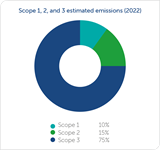Mitigating climate change and improving eco-efficiency
Our focus is on further reducing GHG emissions while growing revenues. Nouryon sees carbon not as a challenge but as a business opportunity and is working towards company-wide alignment on GHG reduction targets and initiatives. This includes exploring innovative solutions and partnerships to reduce GHG emissions across our value chain.
- Scope 1: improving efficiency in our operations and optimizing our fuel mix.
- Scope 2: increasing our use of renewable energy through power purchase agreements, on-site renewables, and green utility programs.
- Scope 3: analyzing and reducing indirect GHG emissions from activities across our value chains.
Our Carbon Business Strategy has a long-term horizon and is overseen by Global Carbon Business Leader Eduardo Nardinelli.
We report greenhouse gas emissions in CO2 equivalents at three levels: emissions from our own operations (Scope 1), emissions from purchased energy (Scope 2), and emissions across our value chain (Scope 3, upstream and downstream). We calculate our GHG inventory (Scopes 1 and 2) as well as other energy and environmental metrics on a quarterly basis and report results to our CR Council and CR Board Committee. This allows us to measure progress against our targets. We also developed dashboards with GHG and eco-efficiency data so that each of our sites worldwide can track their performance, using a site-at-a-glance tool. Furthermore, we have developed internal reports and guidance procedures that describe our calculation methodology so we can ensure year-to-year consistency.
Looking for tables and graphs of our GHG, Energy Management or other environmental performance?
See our annual sustainability data reporting and sustainability report for details and footnotes.

Life-cycle assessment (LCA)
To support our customers, we use life-cycle assessment (LCA) to assess and improve the environmental performance of our products in the value chain. A product carbon footprint (PCF) is one of the many environmental impact categories resulting from the LCA. It calculates total GHG emissions – CO2, and other greenhouse gases (expressed as CO2 equivalent) – generated by a product during its life cycle. PCFs provide our customers with valuable information for assessing greenhouse gas emissions and provide transparency regarding GHG emissions, associated with our products.
We will reduce emissions through a wide range of actions, with a focus on Carbon Operation Excellence, Energy Efficiency and Innovation, and additionally, Value Chain Collaboration on Scope 3.
Examples:
The chemical sector plays a key role in enabling more sustainable and circular production. Improving the eco-efficiency of our facilities is a key component of our approach to sustainability. We use a dashboard to track eco-efficiency parameters, including GHG emissions. Our sites track these in order to gauge performance. We are also constantly innovating to create more sustainable and circular products. This includes using renewable feedstocks such as cellulose instead of fossil-based feedstocks, and circular production methods, such as co-locating with customers to minimize transport and create shared resource models. We use bio-based steam in our our Integrated Manufacturing sites in Brazil. For example: site management continuously looks for ways to reduce environmental impact, waste generation, and energy consumption through objective plans and targets in the site’s Improvement Plan. Each site management team is responsible for maintaining an Environmental Management System that identifies significant environmental impacts and ensures they are properly managed.
Find details on our Energy management (table) in our annual sustainability data reporting page.
Each location also establishes annual targets for energy reduction and considers the best available technologies. Each site completes a water balance assessment and is aware of the sustainability issues associated with the water supply at the facility. In addition, sustainability reviews, including carbon efficiency, are conducted for capital-expenditure projects above a certain monetary threshold. We use a dashboard to track eco-efficiency parameters, including GHG emissions. Our sites track these in order to gauge performance. We are also constantly innovating to create more sustainable and circular products. This includes using renewable feedstocks such as cellulose instead of fossil-based feedstocks, and circular production methods, such as co-locating with customers to minimize transport and create shared resource models.
Curious? Learn more about how we use bio-based steam in our Integrated Manufacturing Model (IMM) sites in Brazil.
In support of our Carbon Business Strategy, and with the support of an external consultant agency, we further enhanced our methodology for our Scope 3 emissions inventory covering estimated emissions across the value chain. We reviewed primary and secondary data sources and refined our approach to build more rigor in our calculations and methodology. In general, we strive to utilize data sources that are temporally relevant and geographically representative. Where possible, we prioritized physical quantities (mass of purchased raw materials and generated waste, miles traveled) over spend-based data. Learn more in our Sustainability report how this is calculated.
Considering emissions across the full value chain helps us build a robust climate strategy, provides further insight into potential reduction opportunities and how these compare with Scopes 1 and 2 reductions, and informs our Scope 3 plans including potential partnerships. A Scope 3 analysis relies upon inherent assumptions, and the approaches and tools will advance over time. For example, Category 12 has a range of uncertainty because of different assumptions of product end-of-life treatment. Despite these uncertainties, the analysis provides helpful insight on the relative footprint of different parts of our value chain.
We will continue to refine our Scope 3 calculations and use the results to inform our pathways to achieve our long-term carbon strategy.

Our solutions can also contribute to GHG emissions reductions for our customers. For example, making packaging lighter with our Expancel® microspheres drives transportation fuel efficiency and reduces transportation-related emissions.
Similarly, our solutions are essential to renewable energy related products such as lightweight composite parts in wind turbines and insulation for high-quality, high-voltage cables, and for helping to make solar panels durable and highly efficient.

In addition to product design, we look for opportunities to reduce waste in our value chain. For example, in our Asa site in Japan, our customers return empty containers for products, so that these can be reused or recycled. In 2022, the Asa site received close to 171,000 containers from our customers for reuse or recycle.
We also use onsite expansion of our Expancel® thermoplastic microsphere product and point-of-use mobile expanders to reduce shipping volumes and costs. Each truck of material our customers expand onsite, saves 30 to 40 trucks. We continually look for ways in which we can ship more efficiently to save costs and reduce our impact. This includes utilizing warehouses closer to customers and reusable dunnage, which provides a dual benefit by reducing packaging waste and eliminating the need for special cleaning at customer sites.
In 2020, 56% of our energy came from low-carbon and renewable sources, such as hydro, wind, solar, biomass for power, and steam from bio-waste. This was a slight increase from the year prior. We have set the goal to further increase the share of our purchased low-carbon and renewable energy to more than 60% by 2025.
For example, we source renewable energy using trusted approaches, such as assets owned by Nouryon, Purchase Power Agreements (PPA) with third parties, or energy attribute certificates backed by recognized industry standards and documentation.
To strengthen our sustainable energy sourcing capabilities, in 2020 we established the Nouryon Energy Team (NET). The NET brings together cross-functional expertise in Energy, Procurement, Operations, and Sustainability to further optimize and develop a comprehensive Energy Management Plan of sustainable and low-carbon energy solutions across the company.
The chemical sector plays a key role in enabling more sustainable and circular production. We are also constantly innovating to create more sustainable and circular products. This includes using renewable feedstocks such as cellulose instead of fossil-based feedstocks, and circular production methods, such as co-locating with customers to minimize transport and create shared resource models. We use bio-based steam in our Integrated Manufacturing Model (IMM) sites in Brazil.
Examples:
To help meet the growing demands of our customers for increased product sustainability, we develop products using bio-based raw materials partly or fully derived from natural sources. Sustainably produced bio-based sources enable a more-circular economy and can also have a lower-carbon footprint versus alternatives across their life cycle, reducing greenhouse gas emissions.
We also use co-product materials as inputs for higher-value products, including tallow, cotton linters, and others. For example, we make rheology modifiers for the paint industry, based on cellulose made from cotton linters.

Our products can help our customers improve the recyclability of their products. For example, we offer polymer catalysts that can adjust the properties of mechanically recycled polymers, allowing them to be upscaled and used in applications currently reserved for new virgin polymer streams.
Our products also help retain high quality in finished products made from recycled plastics.


